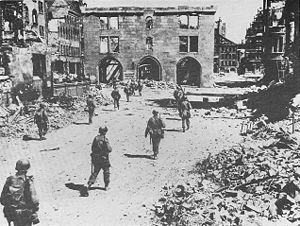Battle of Nuremberg (1945)
| Battle of Nuremberg | |||||||
|---|---|---|---|---|---|---|---|
| Part of the Western Allied invasion of Germany during World War II | |||||||
 American soldiers of the 3rd Infantry Division walk through a devastated Nuremberg. |
|||||||
|
|||||||
| Belligerents | |||||||
|
|
|
||||||
| Commanders and leaders | |||||||
|
|
|
||||||
| Strength | |||||||
| 45,000 troops | 2 divisions, 2 regiments Several ad-hoc units of Luftwaffe and Volkssturm RLA volunteers |
||||||
The Battle of Nuremberg was a five-day battle between the forces of the United States 7th Army on one side, and Nazi Germany and Russian Liberation Army volunteers on the other during World War II. The battle saw some of the fiercest urban combat during the war and it took four days for the United States to capture the city. The battle was a blow to Nazi Germany as Nuremberg was a center of the Nazi regime. Many rallies took place in the city and to lose the city to the Americans took a heavy toll on already low German morale. Even though American forces heavily outnumbered the German forces, it wasn't until 20 April, that the 7th Army took the city center. The battle devastated the city.
The United States, United Kingdom, France and Canada jointly invaded Germany from the west on 8 February 1945. The German Army took heavy losses as the Allied armies crossed the Rhine and surrounded the Ruhr area as the Soviet and Polish armies pushed from the east. By April the US and Soviet armies were closing in on each other, constricting an already narrow gap of German-controlled territory running from Berlin to Munich and including Nuremberg. As the 12th Army Group continued to push east towards Berlin, the 6th Army Group received orders to push into southern Germany and into Austria. Despite the heavier resistance from the German Army in the south as compared to the north, the US 7th Army broke out of its bridgehead on the Rhine south of Frankfurt on 28 March. After fierce fighting, the 7th Army captured Aschaffenburg in Bavaria on 3 April and Heilbronn in Württemberg on 12 April, which left Nuremberg wide open to American attack. On 12 April the German High Command ordered the unconditional defense of all cities and Hitler placed Reich Defense Commissioner and Gauleiter of Franconia Karl Holz in charge of the German Army around Nuremberg. On 15 April the 7th Army advanced towards Nuremberg, rapidly capturing Bamberg in the process. As the 7th Army neared Nuremberg, Holz ordered setting up anti-tank barriers as well as anti-aircraft guns around the old city. Holz's forces were heavily outnumbered, but he still believed that "the Americans would break sooner or later".
...
Wikipedia
